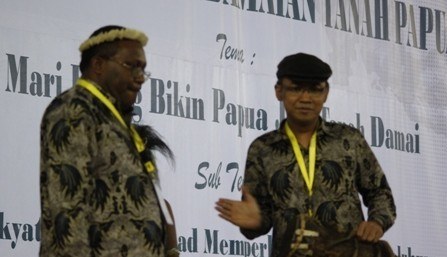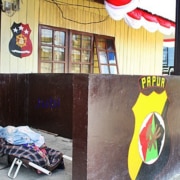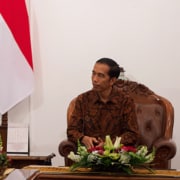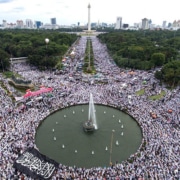This post is the second in a three-part series.
It is rare that a senior Indonesian official states publicly, as retired general Bambang Darmono recently did, that many Papuans want independence. Yet it is this fear that has underpinned the post-Soeharto governments’ Papua policies. It is also a fear that makes peaceful resolution (as in Papuan proposals for dialogue) so difficult for the Indonesian government to embrace. Jakarta thinks dialogue means discussing independence. Likewise, effective decentralization, as envisaged in Law No. 21 of 2001 on the Special Autonomy of Papua, involves devolving authority and revenue to Papuan elites suspected of pro-independence sympathies.
Despite President Joko Widodo’s genuine desire for peace in Papua, it appears Papuan calls for political dialogue will remain unheeded (see “Dialogue missing in Jokowi’s Papua policy,” published last week in Indonesia at Melbourne). Papuans across a wide political spectrum have advocated dialogue with the Indonesian government since the fall of Soeharto. A dialogue-based strategy to resolve the conflict was developed from 2009 by the late Indonesian Institute of Sciences (LIPI) researcher, Muridan Widjojo, and Neles Tebay, Papuan pastor and leader of the Papua Peace Network. In fact, dialogue aims to establish Papua as a “land of peace,” not call for independence. The Papua Peace Network sees itself as the facilitator of dialogue, and has said it does not wish to determine the outcome of the dialogue.
LIPI’s Papua Road Map identified three sources of the conflict:
- Marginalization and discrimination felt by Papuans as a result of development and cultural policies, as well as mass migration of Indonesians into Papua
- Conflicting interpretations of the history of Papua’s integration into Indonesia held by Papuans and the Indonesian government, and related very different constructions of identity
- Papuans’ experience of state violence at the hands of the security forces
The Papua Peace Network mobilized support for the dialogue strategy through public consultations in nine regions of Papua. Consultations were also held with Indonesian settler communities. This culminated in a Peace Conference in July 2011, opened by Djoko Suyanto, the coordinating minister for political, legal and security affairs at the time, and attended by Bambang Darmono, then head of the Unit for the Acceleration of Development in Papua and West Papua (UP4B), along with some 500 Papuans. Although in retrospect, Darmono considered that the conference set unacceptable conditions for dialogue, President Susilo Bambang Yudhoyono announced that his government was willing to pursue the strategy and held meetings with two groups of church leaders in December 2011 and February 2012. The nature and outcome of subsequent confidential meetings with the Papua Peace Network are unclear.
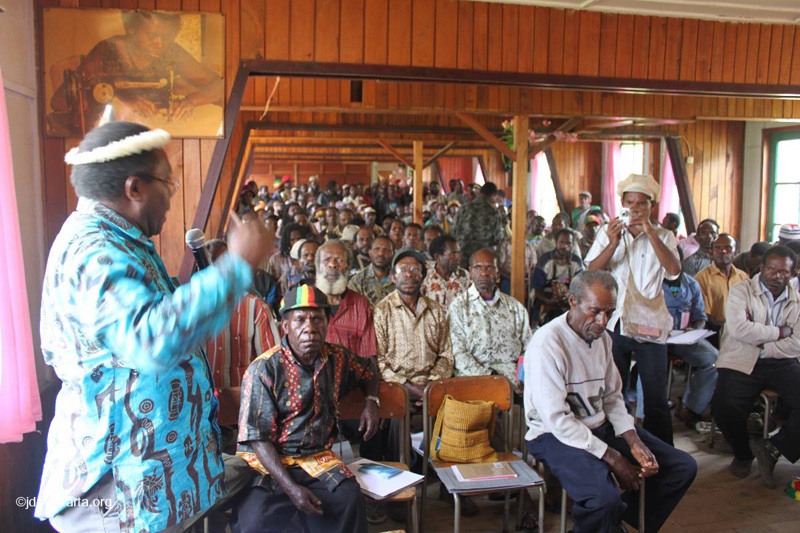
Pastor Neles Tebay leads a public consultation to build support for dialogue, in Enarotali in 2010. Photo courtesy of Jaringan Damai Papua.
Jokowi raised hopes for a dialogue during his first visit as president at Christmas 2014, shortly after four students were killed by the security forces in Paniai district. A meeting with Jokowi was arranged so that Neles Tebay, who was among the church leaders who met Yudhoyono in February 2012, could explain the dialogue approach. Neles urged the president to initiate an inclusive dialogue that involved those fighting for independence as well as activists in exile. He argued that the use of violence would not solve the problem.
In the aftermath of Jokowi’s second visit, Papuan support for a dialogue remains strong and widespread. Its backers include members of the provincial legislature, church leaders and student activists. In addition to opening a comprehensive dialogue to resolve the Jakarta-Papua conflict, senior Protestant figure Dr Karel Phil Erari has urged that human rights abuses suffered by the Papuan people needed to be addressed through the establishment of Truth and Justice Commission, as mandated by the 2001 Special Autonomy Law. Symbols of Papuan cultural identity, particularly the Morning Star Flag, should be recognized, it was by President Abdurrahman Wahid in 2000, rather than its display criminalized, as under subsequent presidents. Erari advocates the establishment of a presidential commission to monitor and evaluate development policies and improving governance to combat corruption.
Jokowi’s second visit was notable as it demonstrated the president’s interest in Papua and his willingness to make symbolic gestures of political significant to Papuans. Yet the visit also exposed the gap between the president’s rhetoric and the measures necessary to begin to resolve the conflict. Particularly worrying was Jokowi’s assertion that meeting customary and religious leaders and local government officials constituted dialogue. More importantly, the subsequent statements by the coordinating minister for legal political and security affairs, as well as senior military and police leaders, revealed differences of approach within the government. The military and police clearly want to preserve the status quo security policies in Papua that have perpetuated the conflict.
Jokowi’s policies in Papua are unlikely to influence the fate of his government. But the policy struggles within the government will test his government’s capacity to break the policy impasse that has afflicted governments since Soeharto fell. Jakarta’s policies have vacillated between repression and accommodation, rarely willing to address the causes of Indonesia’s last and most intractable regional conflict.
